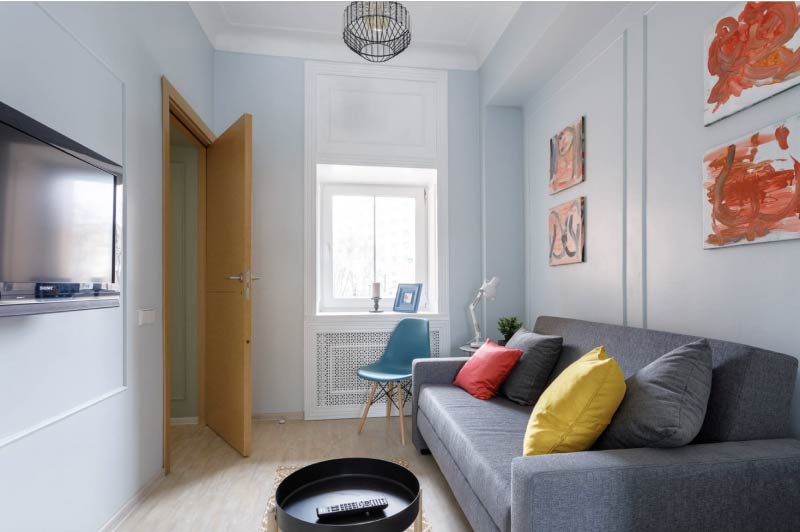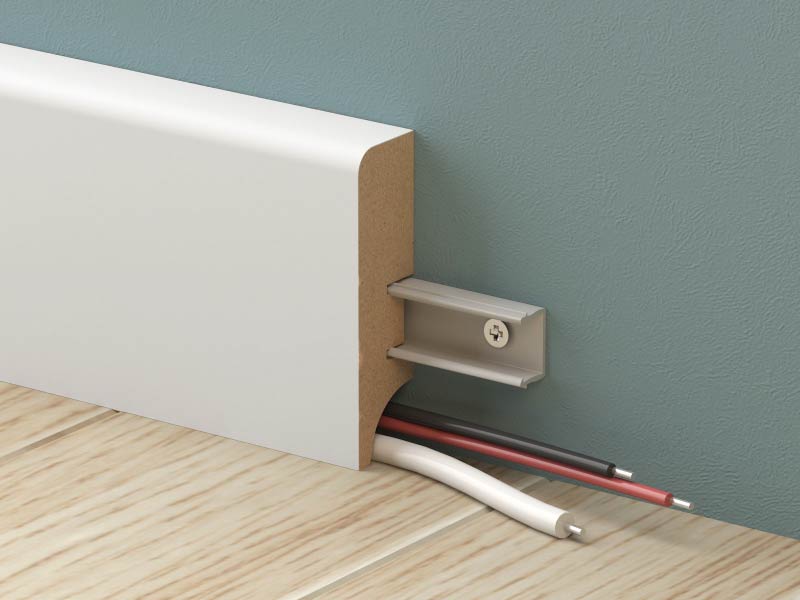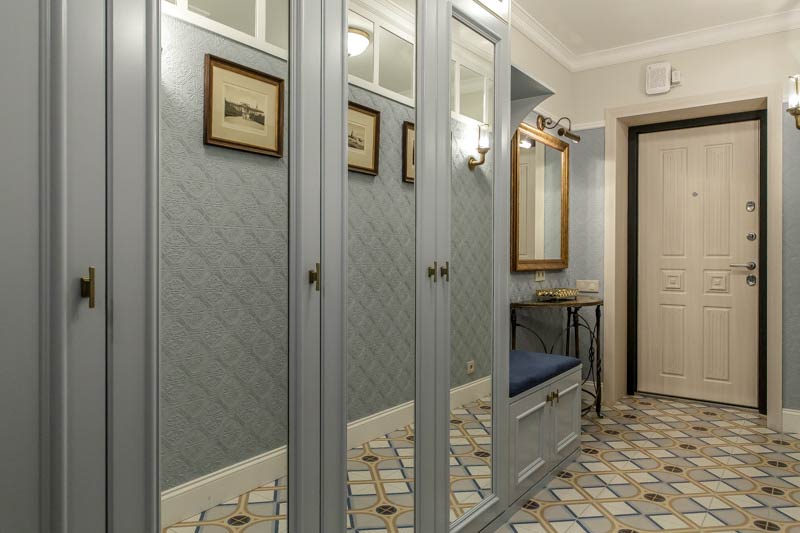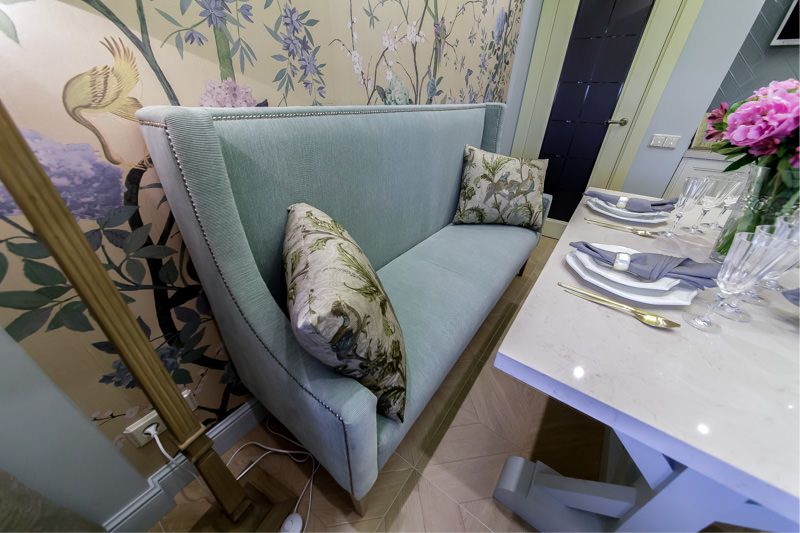Floor plinths for an interior are as a frame for a photo. They can either spoil everything, or harmoniously complete the interior decoration and even visually correct some of the room’s flaws. And, of course, baseboards are needed to mask the wires and the joints of the walls with the floor. We tell and show on the example of 50 photos, how to choose a baseboard for the floor in color, shape and material.

Plastic plinth in the color of the laminate in the interior of the bedroom
Part 1. How to choose floor baseboards by color
How to choose the color of the plinth? Here are 5 principles used by designers (the list is sorted by decreasing degree of popularity, click on the rule you are interested in to start reading immediately, or simply continue in order):
- The tone of the door and / or door trim
- In tone of a floor
- In the tone of the walls
- A tone darker than the walls
- In the tone of window frames
The following rules are also allowed:
- In the tone of any element of the interior (curtains, carpet, furniture, etc.)
- In tone with the rest of the stucco elements in the room
- Plinth as an interior accent
Principle 1. Plinth for the floor in the tone of the doors and / or door trim
This is the first decision that comes to mind when choosing the color of the plinth for the floor. And it really works almost always, regardless of whether the elements are of a contrasting or neutral color. This rule is especially relevant if:
- Doors and / or door trim contrasts against the background of the walls and the interior as a whole, and they need to fit harmoniously into the space;
- The flooring, doors and baseboards have already been selected, but baseboards cannot be combined with doors. The problem is solved as follows: only door door trims are selected or painted to match the baseboards.
Speaking of door frames. We hurry to make a small clarification:
Skirting boards for the floor must match the color of the door trim, but with the doors themselves - not necessarily. So, for example, the door can be bright, and baseboards and platbands can be neutral in color, say, white or in tone with the walls.
Here are a couple of photos of floor plinths in the color of the doors in the interior.


Design tip:
- The most traditional decision which never bothers and fits practically into any interior: doors, platbands and baseboards in white. Below is a small selection of photos of white plinths in the interior.

White floor plinths, door trim and doors are a universal and win-win solution that always adds space to lightness and, at the same time, ennobles it. Contrary to popular myths, it is also very practical.
Principle 2. Plinths in floor color
Another obvious principle for choosing a plinth is the color of the floor. In theory, this solution seems simple, but in practice you can encounter two problems:
Problem 1. It is difficult to choose a baseboard in the color of the floor with a 100% match. With that, even a small raznoton turns out noticeable, somewhat disturbing the overall harmony of the interior.
Decision: It is best to choose a plinth and floor covering from the same collection of the manufacturer. So pick up the plinth to laminate flooring, linoleum, ceramic tile or cork floor will be quite easy.

PVC plinth in the color of laminate in the kitchen
Problem 2: How to join the baseboard in the color of the floor with doors and platbands of a different color, especially if they are already installed?
Decision: If the shades of the doors, the floor and the baseboards are similar or just blend well (see photo below), then the situation is quite acceptable. And if not, then you can save the situation by painting / picking up only the trim panels in tone with the baseboards and floor. If the door completely knocks out of the interior, then it must be supported by adding furniture or decor of the same tone.

Here is a small selection of photos of plinths in the color of the laminate in the interior.

Baseboard in the color of the floor in the living room

Plinth in color of a floor

Plinth in laminate color
Principle 3. Plinth in the color of the walls
A cool solution if:
- If a the room has low ceilings, the baseboards painted / matched to the walls will visually make them taller. So this technique is often used in the design of low apartments in the Khrushchev (in the photo) and other panel houses.

- If you want to create an ultramodern or minimalist interior, “invisible” baseboards will not crush space once again.

- If the walls in the room have different colors, then the skirtings matched to them in tune will accentuate the color block effect.


- Wallpapers will look even more spectacular if the edging of the floor has the color of an element of the pattern.


Plinth for a floor in color of walls
But how then to be with door frames and ceiling plinths? They can be universal white, painted / matched to the walls, repeat any color that already exists in the interior (for example, the color of the floor, curtains, etc.).

Design tip: If you are ready for bold decisions, then you can paint in the color of the walls not only baseboards, but also door trims, doors and ... furniture.

Principle 4. Skirtings on the tone darker than the walls.
This technique is non-trivial, but it is suitable even for the most classic and traditional interiors. It is good in that it can emphasize the interesting color of the walls, create the illusion of higher ceilings, facilitate the already overloaded with contrasts and color space.


Design tip: If you paint to match the plinths for the floor and the ceiling cornice, the interior will be doubly effective.

Principle 5. Plinths in the tone of window frames / slopes
If the window frames have a color that is expressive or contrasting with the interior, the edging of the floor can support them.
Design tip: It is logical to complete the picture by selecting the doors with platbands to match the baseboards and window frames.
Part 2. How to choose a plinth by type and material
Now let's talk about the practical side of the issue. Which skirting is better to choose? The main thing you need to decide is the material. Here are the main options:
- PVC;
- Polyurethane;
- MDF;
- Solid wood;
- Bung;
- Metal;
- Ceramics.
Let's look at each type of plinth in more detail.
Option 1. PVC plinths
PVC skirtings are the best skirting boards for economy-repair, repair of removable housing, balconies, villas and verandas. After all, they are the cheapest, but at the same time wear-resistant workhorses. And most importantly - they are suitable for not perfectly smooth walls. Especially good PVC plinths combined with linoleum and laminate.

Price per meter: from 35 rubles
Options: flexible (soft), with cable channel, self-adhesive, with rubberized upper edge.
Designs: under the tree (about 30 shades) with a matte finish and laminated.
Installation: glue method or using screws (secret mounting).
| pros | Minuses |
|---|---|
| The lowest price | Simple and ordinary look. Create a designer interior with plastic baseboards will not work |
| They are not afraid of high humidity, therefore they can be used both in kitchens, and in bathrooms, on verandas | Over time, they can move away from the wall. The weak point of plastic baseboards - in the outer corners. |
| Wear resistant | It is not always possible to find a plinth of the desired shade and with a suitable pattern |
| You can choose together with the laminate from the collection of the manufacturer | Dents and scratches may appear, especially they are visible on dark plinuts. |
| Assembly and disassembly, fitting and trimming are very easy. | Corners of plastic plinths never match the pattern and tone with the baseboards themselves by 100% |
| Thanks to its low cost, the plastic baseboard can be easily changed as needed. | |
| Due to the fact that the PVC plinth is hollow inside, it can hide not one but several wires at once |

PVC baseboard in the color of the floor in the hallway
Tip:
- If the walls are not perfectly smooth, you should choose baseboards with rubberized edges. With them it is easier to achieve a tight junction to the wall;
- PVC plinths are desirable to buy with laminate;
- If high white plinths do not fit into the budget, pay attention to high PVC plinths as in the photo below (sold in building hypermarkets);
- When buying PVC plinths, make sure that all products are released from the same batch. The fact is that due to the peculiarities of the production, the same baseboards from different batches are always slightly different in tone. This may not be noticeable in the store, but the difference will be visible in the edging of the floor.
Option 2. Polyurethane skirting
Another type of plastic plinth, but much nicer and more beautiful. It is combined with all types of flooring.

Price per running m: from 200 rub.
Options: standard solid, flexible (heated by a building dryer and takes the rounded shape of a wall / column), with a cable channel.

Installation: glue way, wide skirtings can be further planted on the screws.
| pros | Minuses |
|---|---|
| Increased fracture strength | High price |
| Service life 30 years | There may be small dents from strong blows with vacuum cleaner, mop, feet. |
| They are not afraid of high humidity, therefore they can be used both in kitchens, and in bathrooms, on verandas | Over time, gaps may appear in the joints, if the walls are very curved, as well as if the glue has failed, or if the installation is of poor quality. |
| Unlike solid wood baseboards, it does not crack, does not swell and does not shrink when the indoor climate changes | |
| As a rule, polyurethane skirtings are sold in white color, already primed and ready for painting. | |
| Externally, polyurethane baseboards are indistinguishable from painted MDF or wood baseboards. They have a beautiful relief and shape, can have different heights. | |
| Polyurethane plinths do not have seams due to the fact that the joints are glued together with adhesive glue and easily puttied | |
| Suitable for non-perfectly smooth walls (unlike MDF and wood counterparts) | |
| Assembly and disassembly, fitting and trimming are easy. |
Tips:
- Polyurethane baseboards are flexible enough to fit to curved walls. But for reliability in the process of installation it is worth preloading.
- Polyurethane baseboards are very similar to products from duropolymer. What is the difference? Duropolymer is harder and more durable than polyurethane, but it has a simpler shape with minimal decor and, moreover, less suitable for non-perfectly smooth walls.
Option 3. Skirtings from MDF
Plinths from MDF are, perhaps, the best plinths for a laminate and a parquet.
Price per meter: from 170 rub.
Options: laminated, painted, veneered (they can not be distinguished from wood, but they are more practical), with a cable channel.

MDF plinths
Installation: glue way, wide skirtings can be further planted on the screws.

| pros | Minuses |
|---|---|
| MDF is stronger than plastic and polyurethane | High price |
| Material stability regardless of indoor climate change | Installation of floor plinths from MDF should be done by a professional who has a special saw in his arsenal. |
| The price is lower than the wooden plinths | Over time, gaps may appear in the joints, if the walls are very curved, as well as if the glue has failed, or if the installation is of poor quality. |
| Withstand small drops on the walls, as they bend a little | MDF plinths with laminated film are not resistant to surface damage |
| The joints of MDF plinths can be carefully puttied with putty | |
| Externally, MDF baseboards are indistinguishable from wooden counterparts | |
| Environmental friendliness | |
| Most MDF baseboards are already painted or finished with melamine film |
Option 4. Floor skirtings from LDF (from Ultrawood)
LDF (light density fiberboard) - This is an eco-material made of pine fiber from the variety Radiata, eucalyptus and resin binders. Baseboards from LDF produce only brand Ultravud (USA).
Price per running m: from 230 rub.
Installation: on screws or glue.

| pros | Minuses |
|---|---|
| LDF is light but firm, does not crumble when cut, easy to cut and self-assembled. | High price |
| Material stability regardless of indoor climate change | Painting required |
| Environmental friendliness | Compatible with straight walls only. |
| Variety of designs | No flexible baseboards |
| Joints of skirting boards made of LDF can be carefully puttied with putty | |
| Moisture resistance (can be used in wet rooms) | |
| Products are already primed and prepared for painting. |
Option 5. Solid wood
Wooden plinths are the most expensive and they are intended at most for the same expensive flooring - wooden and stone. However, they cannot be called the best in quality.

Prices: from 230 rub.
| pros | Minuses |
|---|---|
| Durability with proper wood quality | High price for good quality wooden baseboards (from precious woods - beech, oak, ash) |
| Environmental friendliness | Dimensional instability due to changes in air temperature and humidity level in the room, and therefore the risk of cracking and bloating of baseboards, as well as the appearance of cracks in the joints |
| Beautiful appearance, compatibility with wooden floors | Only suitable for perfectly flat walls! |
| You can run into fakes - baseboards glued together from several layers of wood, which eventually begin to stratify | |
| Dentures and scratches quickly appear on the plinths of soft wood | |
| The complexity of installation. The installation of wooden plinths should be done by a qualified master. |
Tips:
- If the plinths of valuable wood do not fit into the budget, there is a solution: floor plinths made of MDF or pine / spruce with veneer.
- To make sure that the wooden plinths were conscientiously sawn in the winter, and not in the summer, check their wrong side. When detecting blue spots from the purchase must be abandoned.
Option 6. Metal
Metal baseboards are an excellent choice for modern interiors, say, loft style, high tech, minimalism. Most often, metal baseboards are made from anodized aluminum or stainless steel.

Aluminum baseboard
Prices: from 200 rub.
| pros | Minuses |
|---|---|
| Durability (service life is more than 30 years) | High price |
| Moisture resistance (can be used in bathrooms, in kitchens) | Only suitable for perfectly smooth walls. |
| Impact strength and kink | Limited choice of designs, suitable only for modern interiors |
| State of the art design | May be scratched |
| Ability to hide multiple wires at once | Corner joints are made overhead corners, which somewhat spoils the look of the edging of the floor and complicates cleaning |
Part 3. How to choose the height of the baseboards for the floor
The height of the baseboards plays a big role in the perception of the interior. The choice of height depends on the height of the walls and the width of the door trim. Here are some practical recommendations (but not strict rules!):
- If the walls are low (up to 2.5 m), then you should choose baseboards up to 5 cm.

- For walls of medium height (2.6-2.8 m) it is better to choose narrow floor baseboards with a height of 7-13 cm.
- If the ceilings are high (more than 2.8 m), then you can choose baseboards above the average - for example, 13-23 cm.

And one more tip: the wider the eaves, the smoother the walls and the floor should be and the greater the risk of seeing gaps in the joints in the future.
Other tips
- Skirting boards for painting can be painted with almost any paint. The main thing is that they are waterproof.
- It is recommended to paint the floor plinths for painting prior to their installation.
- Skirtings for the floor can be painted independently (it is cheaper and even a beginner can do it) or order painting at the place of sale (this will be more expensive, but easier).
- Remember that skirtings can always be returned within 14 days after purchase, for example, if they did not fit in shade.
- If ceramic tiles are laid on the floor of the bathroom or kitchen, the plinth can also be made of ceramic tiles.
- How to join tile and laminate with or without a threshold - 5 solutions
- How to lay a tile with your own hands
- Gender is relative: choose flooring for the kitchen
- Self-leveling kitchen floor
- All about grouting for tiles - ranking the best manufacturers and a 4-step optional guide
- Floorboard in the kitchen - all the pros and cons
- Everything about linoleum for the kitchen - compare, choose and lay your own hands























